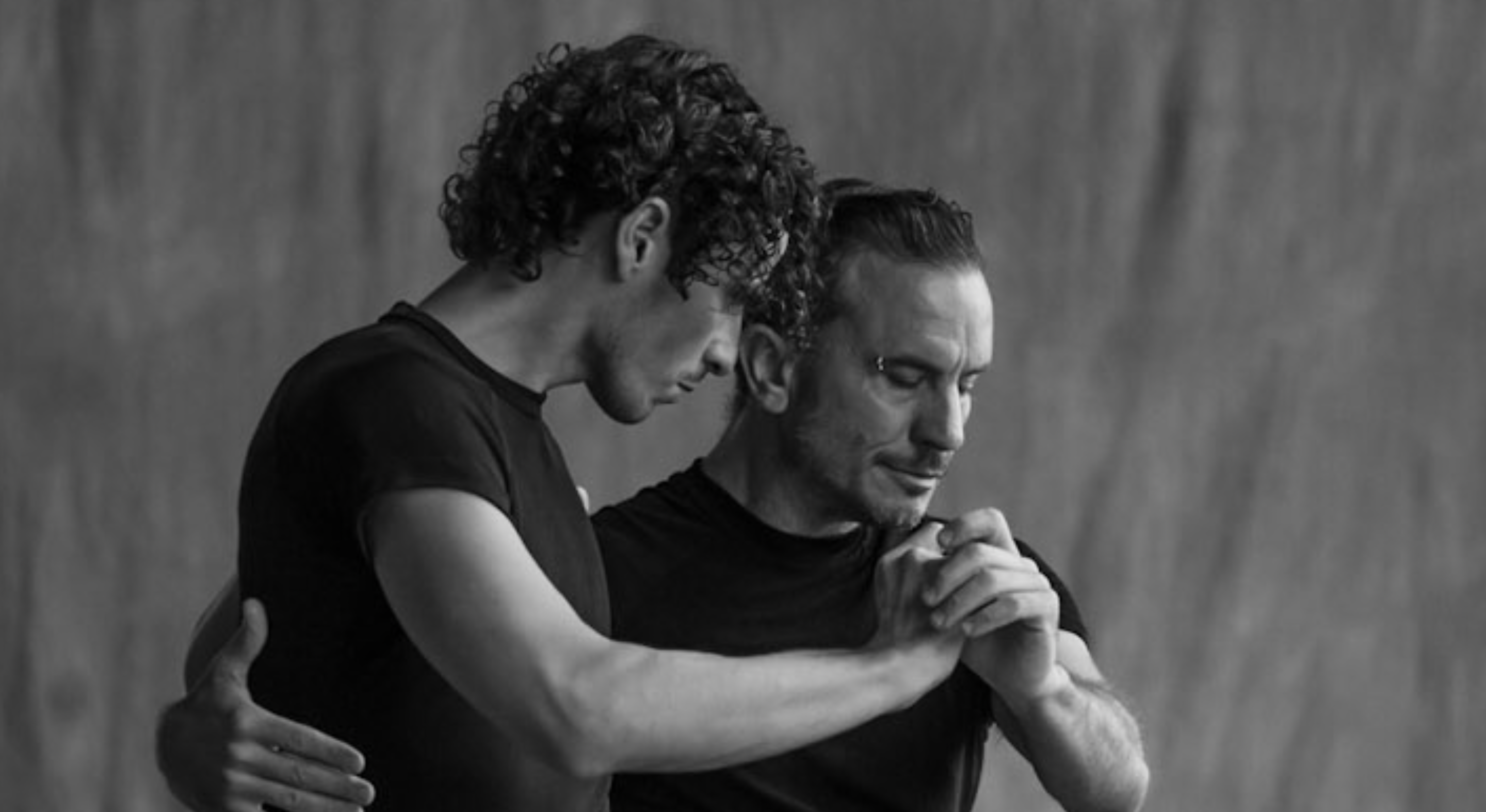Archives
Production 2004:
Production 2005
Production 2007
Production 2012
Production 2013
Jacob’s Pillow 2014
Production 2016
Production 2017
Production 2019
Production 2020
POSTERS
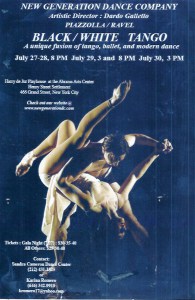

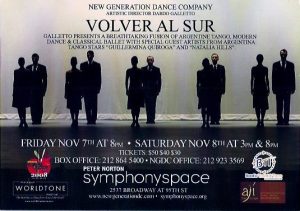

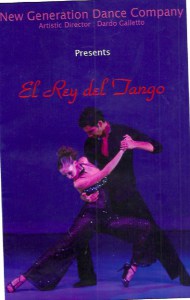





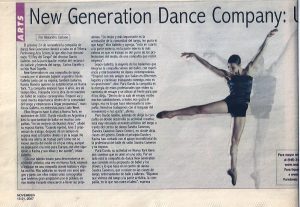
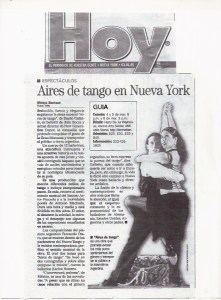


Tango and the Embodied Negotiation of Intersubjectivity
Unable to attend the lecture mentioned back in March? Here it is, published with permission from Wilma S. Bucci, Ph.D.
William Alanson White Psychoanalytic Society 2015-2016 Colloquium Series
April 13, 2016 8:00 pm, New York, NY
“The Tango is a sad thought that you can dance.”
There are many characterizations of tango – maybe that is the most famous one. The idea of sadness certainly doesn’t cover it adequately.
“Warning: tango contains highly addictive ingredients such as pain, pleasure, passion, excitement, connection, freedom, torment, and bliss. In seven out of ten cases it takes over a person’s life.” –Naomi Hotta
And two quotes from Jorge Luis Borges:
“The tango is a direct expression of something that poets have often tried to state in words: the belief that a fight may be a celebration.”
“The tango can be debated, and we have debates over it, but it still encloses, as does all that which is truthful, a secret.”
Tango is an exceedingly exciting and evocative dance. Where does the excitement come from?
I want to be clear here that we’re talking about Argentine tango; the kind of tango that is associated with ballroom dancing is another dance– more showy, less internal.
I think part of the mystery of Argentine tango lies in the special nature of the body movements and their connections to emotion.
At least since Darwin, scientists have argued that different emotions give rise to specific body movements, are expressed through such movements, in humans as in all species. Feelings of joy, sorrow, anger, and all sorts of multiple complex feelings that are not so easy to name are expressed in a person’s face and body and communicated to others through their own bodily responses. This kind of embodied emotional communication is central to the psychoanalytic interaction, which you are all familiar with, and I’ve written a lot about that.
Here I’m talking about a different idea – part of the same cycle but starting in a different place– that particular body movements give rise to different emotions – not just that we express how we feel through facial expression and body movement, but that by moving our bodies a certain way we can make ourselves feel a certain way.
This is related to body therapy, such as Pat Ogden talked about here a month or so ago, but related as well as to all forms of psychotherapy – recognition and use of the effects of certain types of movement on emotion.
In psychology and neuropsychology we are just beginning to learn more about these connections. There is now some evidence from neural imaging studies that feedback from muscle movement is associated with activation in brain regions such as the amygdala, which is related to production of certain neurotransmitters.
In very general terms, we can say that by moving your body in certain ways, the dancer might be doing the equivalent of giving oneself a shot of some neural transmitter, maybe in some cases endorphins, the body’s own self-produced opiates; in some cases oxytocin, the chemical associated with yearning and love; in some cases transmitters associated with anger, aggression or passion.
No one knows precisely how particular body movements are related to particular emotions; no one can name the nature of the complex emotions that are evoked. Dardo is studying the effects of movement from the inside, teaching what he finds out in himself – not connected to specific emotions but in a more general way. He gives specific instructions like: “Be quiet and experience your Achilles; you can feel where you come from, where you are going”. He says from feeling it that the Achilles connects to the inside; the toe, ball of the foot connects to the outside; one side moves the other. This is part of how the spiral happens, the interplay of horizontal and vertical. The vertical direction—ankle, knee, hip, and center within our bodies is what makes the connection of the ground to the self, and the horizontal goes across to the other– involves responding to the partner and moving together around the room. The center is the point where the horizontal and vertical intersect and also where self and other connect.
This sounds mystical, but it’s not. As a potential scientific direction, I could see this kind of articulation of the experience of movements as a basis for a set of hypotheses concerning the relation between combinations of body movement and complex emotions and also for a set of hypotheses concerning communication of emotion to others. At some point I think it could happen that researchers studying the relation of body movement and emotion could use experts like Dardo in designing new types of psychophysiological studies. For example, ask people to move in certain specific ways involving toes, heels, ribs, shoulders and associate to those – maybe report how they feel now, maybe remembering events of the past, maybe have fantasies. I can even foresee people in FMRI (imaging) studies viewing different types of movements with characteristics such as those defined by Dardo and seeing which parts of the brain light up.
I think the relation of different kinds of movements to different emotional states within oneself and to communication of emotion states to others is part of the reason why tango becomes so addictive. Dardo’s instructions are “Follow yourself, feel your body, follow your body,
Tango is an exceedingly exciting and evocative dance. Where does the excitement come from?
I want to be clear here that we’re talking about Argentine tango; the kind of tango that is associated with ballroom dancing is another dance– more showy, less internal.
I think part of the mystery of Argentine tango lies in the special nature of the body movements and their connections to emotion.
At least since Darwin, scientists have argued that different emotions give rise to specific body movements, are expressed through such movements, in humans as in all species. Feelings of joy, sorrow, anger, and all sorts of multiple complex feelings that are not so easy to name are expressed in a person’s face and body and communicated to others through their own bodily responses. This kind of embodied emotional communication is central to the psychoanalytic interaction, which you are all familiar with, and I’ve written a lot about that.
Here I’m talking about a different idea – part of the same cycle but starting in a different place– that particular body movements give rise to different emotions – not just that we express how we feel through facial expression and body movement, but that by moving our bodies a certain way we can make ourselves feel a certain way.
This is related to body therapy, such as Pat Ogden talked about here a month or so ago, but related as well as to all forms of psychotherapy – recognition and use of the effects of certain types of movement on emotion.
In psychology and neuropsychology we are just beginning to learn more about these connections. There is now some evidence from neural imaging studies that feedback from muscle movement is associated with activation in brain regions such as the amygdala, which is related to production of certain neurotransmitters.
In very general terms, we can say that by moving your body in certain ways, the dancer might be doing the equivalent of giving oneself a shot of some neural transmitter, maybe in some cases endorphins, the body’s own self-produced opiates; in some cases oxytocin, the chemical associated with yearning and love; in some cases transmitters associated with anger, aggression or passion.
No one knows precisely how particular body movements are related to particular emotions; no one can name the nature of the complex emotions that are evoked. Dardo is studying the effects of movement from the inside, teaching what he finds out in himself – not connected to specific emotions but in a more general way. He gives specific instructions like: “Be quiet and experience your Achilles; you can feel where you come from, where you are going”. He says from feeling it that the Achilles connects to the inside; the toe, ball of the foot connects to the outside; one side moves the other. This is part of how the spiral happens, the interplay of horizontal and vertical. The vertical direction—ankle, knee, hip, and center within our bodies is what makes the connection of the ground to the self, and the horizontal goes across to the other– involves responding to the partner and moving together around the room. The center is the point where the horizontal and vertical intersect and also where self and other connect.
This sounds mystical, but it’s not. As a potential scientific direction, I could see this kind of articulation of the experience of movements as a basis for a set of hypotheses concerning the relation between combinations of body movement and complex emotions and also for a set of hypotheses concerning communication of emotion to others. At some point I think it could happen that researchers studying the relation of body movement and emotion could use experts like Dardo in designing new types of psychophysiological studies. For example, ask people to move in certain specific ways involving toes, heels, ribs, shoulders and associate to those – maybe report how they feel now, maybe remembering events of the past, maybe have fantasies. I can even foresee people in FMRI (imaging) studies viewing different types of movements with characteristics such as those defined by Dardo and seeing which parts of the brain light up.
I think the relation of different kinds of movements to different emotional states within oneself and to communication of emotion states to others is part of the reason why tango becomes so addictive. Dardo’s instructions are “Follow yourself, feel your body, follow your body, learn from your body. Then he says, “Take care of yourself in order to take care of others.”
This leads to the next unique aspect of tango, the nature of the partnering. In tango, there is a basic set of steps that can be learned, but the sequence of movements is not fixed. Tango is improvisational, there are no fixed combinations.
In finding a joint direction together, the leader has to know where the follower is, the follower has to know what the leader will do; the leader signals his intent through his body before he knows himself; the follower feels the direction in her body.
Here’s a central point, which Dardo emphasizes, and which I’ve written about. In the dance we need to have a moment of waiting, not knowing what is coming next (the moment of maybe) for the dancing to be real; for it to be connected to emotion.
What we do next is not known, in a sense does not exist until the two partners construct it. It is a moment of uncertainty, waiting, risk, it is the creative moment – being on the edge, not quite knowing what will happen. There are such moments of uncertainty in all arts and creative thought – a feeling of emptiness, not knowing what is coming. In the tango it is a unique kind of creative moment in that it is shared by two people – they may follow steps but they still have to create together, explore together.
Dardo has talked about this moment of waiting as:
* To rest – not to sleep – the Spanish word – like to go on a vacation – to discover new places to be, in this case it’s a new place within oneself or in the other.
He also says: “If you don’t let yourself lose balance you will not progress.”
So what we have in tango is a set of movements that activate a range of different emotional experiences including sadness, yearning, love and anger, that activate memories and fantasies, all communicated between two people. You have moments of risk and uncertainty, not knowing what is coming, being on the edge. All of this is happening in a limited specified time and place, the time of a song or a few songs, and all of this may happen with a person who plays no other role in one’s life, perhaps whom you know only in the dance world.
The reason we are talking about it here, and doing this presentation in this place, is that such creative exploration into the unknown is the essence of psychoanalysis – what makes it different from other forms of psychotherapy – and what makes it an experience in itself in addition to being a healing art. The only way to get better – as an analytic patient or as a tango dancer is to enter a zone without quite knowing what will be there.
As others will tell you, Dardo’s a dancer, teacher, and choreographer. I wanted to say a few words about him as a teacher and my relationship to him.
My husband and I have taken lessons from him for many years, both in class and private. As you can see, looking at us, he teaches people of a wide range of ages and body types, and different degrees of talent, degrees of knowledge of dance. In his teaching in classes, he will do lots of demonstrations, some amount of breaking down the movement into steps or feeling particular parts of the body (ten toes, ribs, and spine), and a lot of positive reinforcement. Never criticism. He does not tell students when they are doing something wrong; he waits until they do it right, so he can say essa.
A couple of unique features about Dardo as partner/teacher: he is exquisitely attuned to feel the movements in his partner/student’s body through his own body when he is dancing with his partner or student. This leads to another special and unique feature – he can tell when his student understands something in his or her body –even a little bit of understanding. I have very often had the experience of feeling that I did something sort of right, that I understood something –a particular twist, or movement in my foot, often very subtle, very small, – I’m saying something like aha (in subsymbolic form) to myself, Dardo says ‘si’, ‘esso’, continue, more; he could feel that I did it a little differently.
>02/23/2011:
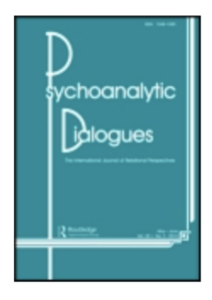
Article by Wilma Bucci, Professor Emerita, Derner Institute of Adelphi University; Co-Director of Research at The New York Psychoanalytic Society and Institute; Honorary Member of the American Psychoanalytic Association, the New York Psychoanalytic Institute and Society, and the Institute for Psychoanalytic Training and Research; Member of Faculty of the Research Training Programme of the International Psychoanalytical Association.
–The Interplay of Subsymbolic and Symbolic Processes in Psychoanalytic Treatment: It Takes Two to Tango—But Who Knows the Steps, Who’s The Leader? The Choreography of the Psychoanalytic Interchange.
Español: Dale click aquí.
PRESS
See PREES DARDO AND ALONSO
See PRESS DARDO GALLETTO
See PRESS ALONSO GUZMAN
DARDO AND ALONSO PRESS
>2023: The Ridgefield Press
>03/21/2023: Dardo and Alonso on Movement at Still Point
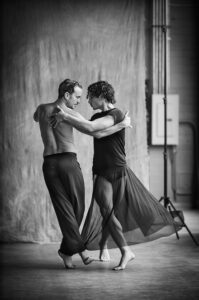
>2023: Intimacy from a Distance by the Brooklyn Rail
>07/20/2018: Tango Feature on Meetup
Dardo Galletto Press
New York Times:
>07/31/2006: When Tango Meets Modern Dance Meets Ballet
>11/07/2008: Listing at The New York Times
>11/10/2008: Whiplash Footwork and Not a Moment of Hesitation
>03/07/2012: Away From Stage, the Tango Turns Revealing and Intoxicating
>09/25/2015: Image – NYTimes.com – Arts
>10/16/2012: Gabriel Missé and Analía Centurión at Dardo galletto Studios
>04/03/2013: High-Speed Stitching, Full of Joy
>08/13/2013: Gabriel Missé and Analía Centurión Dance Tango
>09/27/2014: Tango Stars Perform at Dardo Galletto Studios
>04/18/2016: Review: Gabriel Missé and Guillermina Quiroga
The New Yorker:
>04/23/2012: Dance Lessons
Other Press:
>03/02/2015: West Side Spirit
Alonso Guzman Press
New York Times
>03/17/2022: Karole Armitage
>2016: The City is a Dance Floor
Karole Armitage
>2016: Mexico Now Festival: Karole Armitage
>2016: criticaldance.org: Karole Armitage
>06/24/2018: Theater Scene: Karole Armitage
>2019: Yahoo.com: Karole Armitage
>03/16/2019: Dance-Enthusiasts: Karole Armitage
>04/12/2019: Dance Log: Karole Armitage
>04/30/2019: Dance Enthusiasts: Karole Armitage
>10/23/2019: Oberon’s Grove: Karole Armitage
>10/29/2019: Arts Journal: Karole Armitage
>02/23/2022: Dance magazine: Karole Armitage
>02/28/2022: Broadway World: Karole Armitage
>03/06/2022: Time Out: Karole Armitage
>03/04/2022: Forbes: Karole Armitage
>03/18/2022: Arts Meme: Karole Armitage
>10/06/2022: Wallpaper.com: Karole Armitage
>03/16/2022: Alonso Guzman on Fjord: Karole Armitage
>01/20/2022: Alonso Guzman on Dance Informa: Karole Armitage
Dance Magazine
>06/28/2020: Dance Magazine
Huffington Post
>2013: Alonso Guzman on Huffington Post:
Other Press
>2016: Alonso Guzman in Summer 2016 Dance International
Myra Schechtman
HOW DARDO AND TANGO HAVE HELPED ME HEAL
If you spend any time here at the studio, you will see Myra steadfastly taking classes and lessons and attending the milongas several days a week. When you learn more about the courage behind her story, you will be inspired to spend as much time as she does, working to reclaim your joy too.
by Myra Schechtman
I have had Rheumatoid Arthritis (RA) since I was 3 years old. I don’t remember too much about having it from back then, except that the other girls could wear these cute little Mary Jane shoes to school while I had to wear clunky, lace-up Oxford shoes because they were supportive and good for my feet. Miraculously the RA went into remission around the time I went off to college. I was no longer in pain and I remember dancing from one fraternity house to the next during pledge week when the houses were open and all the music flowed into the streets to lure the pledges in. I forgot pain and suffering for so many delightful years.
I eventually married and had a son. It was with the birth of my son 28 years ago that the RA came back: first in my hands and fingers as I lifted him in and out of the crib, and then in my knees and ankles as I chased after him as a toddler. I remember from this time. Rheumatoid Arthritis is a systemic disease which means it is in one’s whole body. I was never sure which joints would swell and hurt and for how long. I would wake up each morning and mentally a do a body check to find out what hurt on that day. If my knees and ankles didn’t hurt too much, I would try to do whatever I could that required walking on that day. If I was sitting, I would try to do whatever I could from a sitting position; if I was standing, I would do the same so I didn’t have to bend or unbend my knees too often. Elevators were my best friends. I remember the withdrawal into myself as my whole being focused on how to minimize my movements to avoid pain, and how I struggled against this to be a “normal” wife and mother. I also remember how caring my husband was, always pitching in with household chores and offering me seats whenever he saw one available. How I hated him for this as it singled out my infirmity while I so loved him for his tremendous consideration and attentiveness. I became fearful of trying new things; afraid they would cause new pain.
My husband passed away 13 years ago; our son went off to college 4 years later and I began a quest to get my life back. I searched for doctors who would see me as a whole person and not a walking illness; who would not push me into taking heavy-duty arthritis medications (one of which had nearly killed me), but would support me in tapering off my 20 years of prednisone use. I searched for a support person who could help me with my medical issues and assist me in figuring out what I wanted in this new life and how to get it. And I searched for communities where I could find new friends and joyous celebrations. I have been blessed to find an integrative doctor and a life coach who are tremendous assistants in my journey. But it was not until I joined the DGS community and more specifically began private lessons with Dardo that I began to truly heal.
I began at DGS four years ago and I began taking private lessons with Dardo about one year later. So, as Dardo says, I am a tango baby. I started fearful my RA would flare-up, or I’d fall and make a fool of myself, or I wouldn’t be able to keep up with the class. I had already fallen twice and broken an elbow in each fall. I knew I didn’t want to do that again but didn’t know how to prevent it. I had had tons of physical therapy, spent hours with awful, elastic therabands and followed all different sorts of treatments, all to no avail. I had even tried tango for a year at another studio and wound up with pains in my right hip and butt from repetitively walking backward for hours at a time. So it is a tribute to both Dardo Galletto and Karina Romero that after seeing them at the 92nd Street Y, I decided to take another chance at tango with them. I recognized that they were excellent dancers and teachers but most important, they cared about their students (an ingredient missing in the other studio).
I took a variety of classes at “Dardo Galletto Studios” but it was with Dardo’s slower, deliberative technique classes that I felt most comfortable. I felt that the slower I moved, the less likely I was to hurt myself or to have a flare-up. After a year of being in his classes, I knew that I wasn’t going to get hurt but something unexpected happened – I got hooked on Tango. My motivation now was not just that I loved to move and dance and tango movement was gentle on my knees and ankles; I now wanted to be the best tango dancer I could be, given my constraints.
I started taking privates with Dardo. For me this was (and continues to be) a transformative experience. I believe it began with his intense but gentle quietness, calmness, confidence which in turn quiets and calms me. It is only when I am quiet/calm that I can release my muscles to dance. Dardo’s training in ballet and his intelligent study/awareness of his own body has given him an almost uncanny ability to see muscles working (or not) in others. And he will quietly suggest movements that will challenge those muscles. (“more twist, Myra; even more”) His lessons are a combination of dancing and exercise so that even though you might be working the same muscles, they are worked in different ways and they do not feel repetitively stressed. Muscles that I never knew existed or thought had atrophied long ago are being stretched and strengthened. Somehow in the course of these lessons, I lost the pain in my hip and butt – he worked a miracle that no physical therapist or expensive Platelet Rich Plasma Therapy (PRP) treatment ever did! Thank you!
His gentle, reassuring manner has allowed me to feel comfortable with myself in the process of learning. He accepts me where I am with the dance (even if I have not done the homework exercises) and he is supportive of my bad days as well as my good. His experience has given him a wisdom that seems to me more advanced than his years would suggest. He sometimes shares this in class but only when asked in the private lesson. He is very respectful. Once, when I was not feeling well, he told me he would like to push me harder and asked if that was OK with me. At the time my old flare-up fears overcame me and I said “no”. He respected that and didn’t push. By the next lesson I had put those old fears back to sleep and told him “yes” and I have been pushing myself with his encouragement (“more, Myra; more”) ever since. If I do a stretch or a twist a little better than usual while we dance, Dardo smiles – I work for those smiles.
I think Dardo is the perfect Tango instructor for someone with physical challenges. His acceptance, respect, and quiet confidence that if you work at it you will do better, allows one to begin to relax, loosen muscles and actually use them constructively. When I was a child my mother would knuckle me between the shoulder blades telling me to stand up straighter. It took lessons with Dardo for me to realize that good posture came from my core and not from between my shoulder blades! He does not make everything explicit but through the exercises and one’s growing constructive awareness of one’s own body, bit by bit things fall into place.
But I think that what Dardo has helped give me is more profound than better posture, or increased ability to stretch/twist or even dance tango. He has helped me recover the joy, the total pleasure I had always found in movement, and the confidence that I can do it – anything! I no longer feel constrained by limits I thought RA had placed on me. Everyone has constraints of one kind or another. I am aware of mine but I can push those limits and work through them. After my husband died and my son left for school, I spent a year grieving and looking through old pictures of myself as a smiling, happy girl. I wanted to get that girl back. I knew the actual youth was gone; but I wanted that joy, that happiness, that love of life – the possibilities of youth, again.
I have worked hard to bring all of it back into my life, but Dardo has been the person who has most helped me regain that joy and inspire those possibilities. From his imperious command in class to “Explore It!” when we are learning something new; to his intense “more, Myra; more” in my private lessons, he has inspired me to move in ways I haven’t since all those fraternity parties. His occasional philosophizing in class about tango and life has inspired me to think differently about myself and discover new possibilities in myself and my world.
All of this has given me overwhelming joy and profound gratitude to all at DGS who have and will help me on this journey – Dardo, Karina, all my dance partners and friends. I could not do this alone.
I wish you all a deeply heartfelt thank you.
